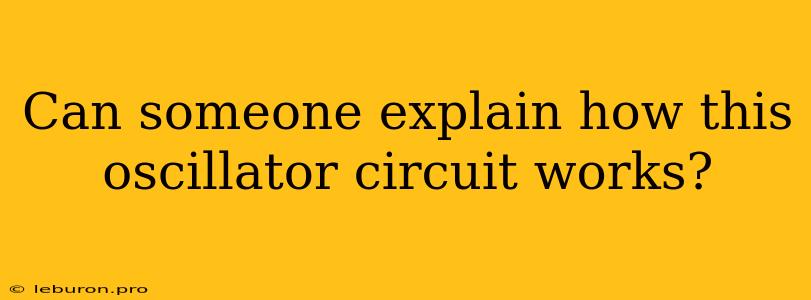Oscillators are fundamental components in electronics, generating periodic waveforms that drive various circuits and systems. Understanding how these circuits function is crucial for both electronics enthusiasts and professionals. One common type of oscillator is the LC oscillator, which relies on the interplay between inductors (L) and capacitors (C) to produce oscillations. This article aims to delve into the workings of LC oscillators, providing a clear explanation of the circuit's operation, its key components, and the factors that determine its frequency.
Understanding the Basics of LC Oscillators
At the heart of an LC oscillator lies a resonant circuit composed of an inductor (L) and a capacitor (C) connected in parallel. The inductor and capacitor store energy in different forms: the inductor stores energy in its magnetic field, while the capacitor stores energy in its electric field. This energy exchange between the inductor and capacitor is the foundation of the oscillation process.
The Resonant Frequency
The LC oscillator's frequency of operation is determined by the values of the inductor (L) and capacitor (C) and is known as the resonant frequency (f_r). This frequency is calculated using the following formula:
f_r = 1 / (2π√(LC))
Where:
- f_r is the resonant frequency in Hertz (Hz)
- L is the inductance in Henries (H)
- C is the capacitance in Farads (F)
This formula reveals that the resonant frequency is inversely proportional to the square root of the product of inductance and capacitance. This means that increasing either the inductance or capacitance will decrease the resonant frequency, and vice versa.
The Oscillation Process: A Step-by-Step Explanation
- Initial Charge: Let's assume the capacitor is initially charged with a voltage. This stored electrical energy is ready to be transferred.
- Energy Transfer to the Inductor: When the circuit is closed, the capacitor starts to discharge through the inductor. As the capacitor discharges, the current through the inductor increases, building up a magnetic field around it.
- Inductor Energy Storage: As the capacitor fully discharges, the current through the inductor reaches its maximum value, and the inductor stores maximum energy in its magnetic field.
- Energy Transfer Back to the Capacitor: With the capacitor fully discharged, the magnetic field around the inductor starts to collapse, inducing a current flow in the opposite direction. This current begins to charge the capacitor again, but with the opposite polarity.
- Capacitor Charge and Continued Oscillation: The capacitor continues to charge until it reaches its maximum voltage, at which point the process repeats. The energy continues to oscillate back and forth between the inductor and capacitor, creating a sinusoidal waveform.
Key Components of an LC Oscillator
While the core of an LC oscillator is the resonant circuit, additional components are essential for its proper operation.
- Amplifier: An amplifier is crucial for sustaining the oscillations. The energy lost due to resistance in the circuit would cause the oscillations to decay over time. The amplifier compensates for these losses by providing a gain, ensuring that the amplitude of the oscillations remains stable.
- Feedback Network: A feedback network is used to provide a portion of the output signal back to the input of the amplifier. This feedback is essential for maintaining the oscillation process by reinforcing the signal.
- Tuning Elements: These elements, typically variable capacitors or inductors, allow for adjusting the resonant frequency of the oscillator. By changing the values of these elements, the frequency of the generated signal can be tuned to the desired value.
Types of LC Oscillators
There are several different types of LC oscillators, each with its own unique characteristics and applications. Some common types include:
- Colpitts Oscillator: The Colpitts oscillator uses a voltage divider formed by two capacitors to provide feedback. This configuration is known for its good frequency stability.
- Hartley Oscillator: The Hartley oscillator uses a tapped inductor to provide feedback, and it is often used in radio frequency applications.
- Clapp Oscillator: The Clapp oscillator is a variation of the Colpitts oscillator that uses an additional capacitor in series with the inductor to improve frequency stability and reduce the effect of stray capacitances.
Applications of LC Oscillators
LC oscillators have a wide range of applications in various fields, including:
- Radio Frequency (RF) Circuits: LC oscillators are essential components in radio transmitters and receivers, generating the carrier frequencies used for wireless communication.
- Clock Generators: In digital circuits, LC oscillators are used as clock generators to provide timing signals for the operation of the circuits.
- Signal Generators: LC oscillators can be used as signal generators, producing precise and stable frequencies for testing and measurement purposes.
Conclusion
The LC oscillator is a fundamental circuit that plays a crucial role in many electronic systems. By understanding the principles of energy exchange between the inductor and capacitor, the role of feedback, and the different types of LC oscillators, one can gain valuable insights into the design and operation of these essential components. Whether you are an electronics enthusiast or a professional engineer, a thorough grasp of LC oscillator theory is essential for working with and designing circuits that rely on these fundamental building blocks.
